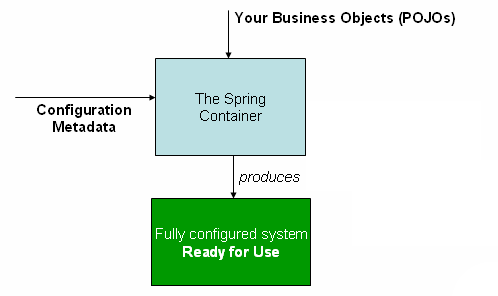Spring
#back-end/spring
The IOC Container
Introduction to the IOC Container and Beans
IoC 也称为依赖注入 (DI)。这是一个过程,对象仅通过构造函数参数、工厂方法的参数或在构造对象实例或从工厂方法返回后在对象实例上设置的属性来定义其依赖项(即它们使用的其他对象)。然后,容器在创建 bean 时注入这些依赖项。这个过程从根本上来说是 bean 本身的逆过程(因此得名“控制反转”),通过使用类的直接构造或诸如服务定位器模式之类的机制来控制其依赖项的实例化或位置。
org.springframework.beans 和 org.springframework.context 包是 Spring Framework 的 IoC 容器的基础。 BeanFactory 接口提供了能够管理任何类型对象的高级配置机制。 ApplicationContext 是 BeanFactory 的子接口。
- Easier integration with Spring’s AOP features
更轻松地与 Spring 的 AOP 功能集成 - Message resource handling (for use in internationalization)
消息资源处理(用于国际化) - Event publication 活动发布
- Application-layer specific contexts such as the
WebApplicationContextfor use in web applications.
应用程序层特定上下文,例如用于 Web 应用程序的WebApplicationContext。
在 Spring 中,构成应用程序主干并由 Spring IoC 容器管理的对象称为 bean。 bean 是一个由 Spring IoC 容器实例化、组装和管理的对象。否则,bean 只是应用程序中的众多对象之一。 Bean 以及它们之间的依赖关系反映在容器使用的配置元数据中。
Container Overview
org.springframework.context.ApplicationContext 接口代表 Spring IoC 容器,负责实例化、配置和组装 bean。容器通过读取配置元数据来获取要实例化、配置和组装哪些对象的指令。配置元数据以 XML、Java 注释或 Java 代码表示。它可以让你表达组成应用程序的对象以及这些对象之间丰富的相互依赖性。
Spring 提供了 ApplicationContext 接口的多个实现。在独立应用程序中,通常创建 ClassPathXmlApplicationContext 或 FileSystemXmlApplicationContext 的实例。
Spring 工作原理

应用程序类与配置元数据相结合,以便在创建并初始化 ApplicationContext 后拥有一个完全配置且可执行的系统或应用程序。
Configuration Metadata
Spring 配置由容器必须管理的至少一个(通常是多个)bean 定义组成。基于 XML 的配置元数据将这些 bean 配置为顶级 <beans/> 元素内的 <bean/> 元素。 Java 配置通常在 @Configuration 类中使用 @Bean 带注释的方法。
这些 bean 定义对应于构成应用程序的实际对象。通常,你定义服务层对象、持久层对象(例如存储库或数据访问对象 (DAO))、表示对象(例如 Web 控制器)、基础结构对象(例如 JPA EntityManagerFactory 和 JMS 队列)等。通常,人们不会在容器中配置细粒度的域对象,因为创建和加载域对象通常是存储库和业务逻辑的责任。
以下示例显示了基于 XML 的配置元数据的基本结构:
|
id属性是一个字符串,用于标识各个 bean 定义class属性定义 bean 的类型并使用完全限定的类名
Instantiating a Container
提供给 ApplicationContext 构造函数的位置路径是资源字符串,让容器从各种外部资源加载配置元数据,例如本地文件系统、Java CLASSPATH 、等等。
ApplicationContext context = new ClassPathXmlApplicationContext("services.xml", "daos.xml"); |
Using the Container
ApplicationContext 是高级工厂的接口,能够维护不同 bean 及其依赖项的注册表。通过使用方法 T getBean(String name, Class<T> requiredType) ,你可以检索 bean 的实例。
ApplicationContext 允许你读取 Bean 定义并访问它们
// create and configure beans |
Bean Overview
Spring IoC 容器管理一个或多个 bean。这些 bean 是使用你提供给容器的配置元数据创建的(例如,以 XML <bean/> 定义的形式)
Instantiating Beans
Bean 定义本质上是创建一个或多个对象的配方。容器在被询问时查看命名 bean 的配方,并使用该 bean 定义封装的配置元数据来创建(或获取)实际对象。
如果你使用基于 XML 的配置元数据,则可以在 <bean/> 元素的 class 属性中指定要实例化的对象的类型(或类)。此 class 属性(在内部是 BeanDefinition 实例上的 Class 属性)通常是强制的。可以通过以下两种方式之一使用 Class 属性:
-
通常,在容器本身通过反射调用其构造函数直接创建bean的情况下指定要构造的bean类,有点相当于Java代码中的 new 运算符。
- 指定包含调用来创建对象的
static工厂方法的实际类,在不太常见的情况下,容器调用类上的static工厂方法来创建 bean 。调用static工厂方法返回的对象类型可能是同一个类,也可能完全是另一个类。
Instantiation with a Constructor
当通过构造函数方法创建 bean 时,所有普通类都可以由 Spring 使用并与 Spring 兼容。也就是说,正在开发的类不需要实现任何特定的接口或以特定的方式编码。只需指定 Bean 类就足够了。但是,根据对该特定 bean 使用的 IoC 类型,可能需要一个默认(空)构造函数。
使用基于 XML 的配置元数据可以指定 bean 类,如下所示:
<bean id="exampleBean" class="examples.ExampleBean"/> |
Instantiation with a Static Factory Method
定义使用静态工厂方法创建的 Bean 时,请使用 class 属性指定包含 static 工厂方法和名为 factory-method 的属性的类指定工厂方法本身的名称。
以下 bean 定义指定将通过调用工厂方法来创建 bean。该定义没有指定返回对象的类型(类),而是指定包含工厂方法的类。在此示例中, createInstance() 方法必须是 static 方法。
以下示例显示如何指定工厂方法:
<bean id="clientService" |
以下示例显示了一个可与前面的 bean 定义一起使用的类:
public class ClientService { |
Instantiation by Using an Instance Factory Method
与通过静态工厂方法实例化类似,使用实例工厂方法实例化会从容器中调用现有 bean 的非静态方法来创建新 bean。
要使用此机制,请将 class 属性留空,并在 factory-bean 属性中指定包含实例方法的当前(或父级或祖先)容器中 Bean 的名称将被调用来创建对象。使用 factory-method 属性设置工厂方法本身的名称。
以下示例展示了如何配置此类 bean:
<!-- the factory bean, which contains a method called createInstance() --> |
以下示例显示了相应的类:
public class DefaultServiceLocator { |
Dependency Injection
依赖注入 (DI) 是一个过程,对象仅通过构造函数参数、工厂方法的参数或对象实例构造后设置的属性来定义其依赖项(即与它们一起工作的其他对象)。从工厂方法返回。然后,容器在创建 bean 时注入这些依赖项。这个过程从根本上来说是 bean 本身的逆过程(因此得名“控制反转”),通过使用类的直接构造或服务定位器模式自行控制其依赖项的实例化或位置。
采用 DI 原则,代码更加清晰,并且当对象提供其依赖项时,解耦更加有效。该对象不会查找其依赖项,也不知道依赖项的位置或类。因此,你的类变得更容易测试,特别是当依赖项位于接口或抽象基类上时,这允许在单元测试中使用存根或模拟实现。
DI 存在两种主要变体:基于构造函数的依赖注入和基于 Setter 的依赖注入。
Constructor-based Dependency Injection
基于构造函数的 DI 是通过容器调用带有多个参数的构造函数来完成的,每个参数代表一个依赖项。调用具有特定参数的 static 工厂方法来构造 bean 几乎是等效的,并且本讨论以类似方式处理构造函数和 static 工厂方法的参数。
以下示例显示了一个只能通过构造函数注入进行依赖注入的类:
public class SimpleMovieLister { |
请注意,这个类没有什么特别的。它是一个 POJO,不依赖于容器特定的接口、基类或注释。
Constructor Argument Resolution
构造函数参数解析匹配通过使用参数的类型进行。如果 bean 定义的构造函数参数中不存在潜在的歧义,则在 bean 定义中定义构造函数参数的顺序就是在实例化 bean 时将这些参数提供给适当的构造函数的顺序。
考虑下面的类:
package x.y; |
假设 ThingTwo 和 ThingThree 类不通过继承相关,则不存在潜在的歧义。因此,以下配置可以正常工作,并且不需要在 <constructor-arg/> 元素中显式指定构造函数参数索引或类型。
<beans> |
当引用另一个 bean 时,类型是已知的,并且可以发生匹配(如前面示例的情况)。当使用简单类型时,例如 <value>true</value> ,Spring 无法确定值的类型,因此无法在没有帮助的情况下按类型进行匹配。
考虑下面的类:
package examples; |
Constructor argument type matching
在上述场景中,如果使用 type 属性显式指定构造函数参数的类型,则容器可以使用简单类型的类型匹配。
如下例所示:
<bean id="exampleBean" class="examples.ExampleBean"> |
Constructor argument index
可以使用 index 属性显式指定构造函数参数的索引。
如以下示例所示:
<bean id="exampleBean" class="examples.ExampleBean"> |
除了解决多个简单值的歧义之外,指定索引还可以解决构造函数具有两个相同类型的参数时的歧义。
The index is 0-based
Constructor argument name
你还可以使用构造函数参数名称来消除值歧义,如以下示例所示:
<bean id="exampleBean" class="examples.ExampleBean"> |
请记住,为了使其开箱即用,你的代码必须在启用调试标志的情况下进行编译,以便 Spring 可以从构造函数中查找参数名称。如果你不能或不想使用调试标志编译代码,则可以使用 @ConstructorProperties JDK 注释来显式命名构造函数参数。
示例类必须如下所示:
package examples; |
Setter-based Dependency Injection
基于 Setter 的 DI 是通过容器在调用无参构造函数或无参 static 工厂方法来实例化你的 bean 后调用你的 bean 上的 setter 方法来完成的。
下面的示例显示了一个只能通过使用纯 setter 注入进行依赖注入的类。这个类是传统的Java。它是一个 POJO,不依赖于容器特定的接口、基类或注释。
public class SimpleMovieLister { |
ApplicationContext 支持其管理的 bean 的基于构造函数和基于 setter 的 DI。在通过构造函数方法注入一些依赖项后,它还支持基于 setter 的 DI。可以以 BeanDefinition 的形式配置依赖项,将其与 PropertyEditor 实例结合使用,将属性从一种格式转换为另一种格式。然而,大多数 Spring 用户并不直接使用这些类(即以编程方式),而是使用 XML bean 定义、带注释的组件(即用 @Component 、 @Controller 等),或基于 Java 的 @Configuration 类中的 @Bean 方法。然后,这些源在内部转换为 BeanDefinition 的实例,并用于加载整个 Spring IoC 容器实例。
Circular dependencies
如果主要使用构造函数注入,则可能会创建无法解析的循环依赖场景。例如:A类通过构造函数注入需要B类的实例,B类通过构造函数注入需要A类的实例。如果你为类 A 和 B 配置 Bean 以相互注入,Spring IoC 容器会在运行时检测到此循环引用,并抛出 BeanCurrentlyInCreationException 。
一种可能的解决方案是编辑某些类的源代码,使其由 setter 而不是构造函数进行配置。或者,避免构造函数注入并仅使用 setter 注入。换句话说,虽然不推荐,但是可以通过setter注入来配置循环依赖。
与典型情况(没有循环依赖)不同,bean A 和 bean B 之间的循环依赖会强制其中一个 Bean 在完全初始化之前注入另一个 Bean(典型的先有鸡还是先有蛋的场景)。
Examples of Dependency Injection
以下示例将基于 XML 的配置元数据用于基于 setter 的 DI。 Spring XML 配置文件的一小部分指定了一些 bean 定义,如下所示:
<bean id="exampleBean" class="examples.ExampleBean"> |
以下示例显示了相应的 ExampleBean 类:
public class ExampleBean { |
在前面的示例中,setter 被声明为与 XML 文件中指定的属性相匹配。以下示例使用基于构造函数的 DI:
<bean id="exampleBean" class="examples.ExampleBean"> |
以下示例显示了相应的 ExampleBean 类:
public class ExampleBean { |
Bean 定义中指定的构造函数参数用作 ExampleBean 构造函数的参数。
现在考虑此示例的一个变体,其中不使用构造函数,而是告诉 Spring 调用 static 工厂方法来返回对象的实例:
<bean id="exampleBean" class="examples.ExampleBean" factory-method="createInstance"> |
以下示例显示了相应的 ExampleBean 类:
public class ExampleBean { |
static 工厂方法的参数由 <constructor-arg/> 元素提供,与实际使用构造函数完全相同。工厂方法返回的类的类型不必与包含 static 工厂方法的类具有相同的类型(尽管在本例中是这样)。实例(非静态)工厂方法可以以基本相同的方式使用(除了使用 factory-bean 属性而不是 class 属性),因此我们不讨论这些细节在这里。